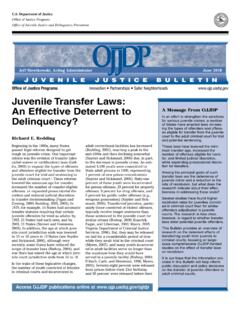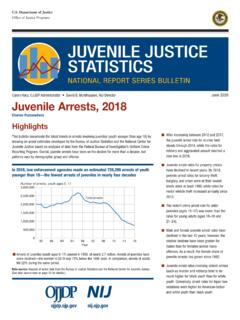Transcription of Juvenile Delinquency - SAGE Publications Inc
1 Juvenile DelinquencyTheories of CausationMany theories have been advanced to explain the cause of juveniledelinquency. Some are quite sophisticated, whereas others arepredicated on rather basic instinctive conclusions that may ormay not have a basis in fact. Many Juvenile curfews are based onan instinctive conclusion that youths are likely to be victimized orget into trouble after certain hours. For example, in August 1994the Town of Vernon, Connecticut, enacted its first Juvenile forbade persons under 18 to be in any public place or busi-ness. The rationale was that town leaders had noticed groups ofjuveniles loitering in town, and prior to the law a teenager had beenmurdered. Surveys also indicated that youths were fearful aboutgangs, weapons, and victimization.
2 According to leaders, the cur-few was passed for the protection of young people and to reducethe incidence of Sunday through Thursday, the prohibited hours were from11:00 until 5:00 , and on Friday and Saturday the prohib-ited hours were from 12:01 until 5:00 Unfortunately for thetown leaders, the curfew law was held to be unconstitutional becauseit unfairly restricted the right of free movement, and hence the equalprotection rights of the time of the first civil communities, every society has declaredcertain modes of behavior to be unacceptable or criminal in customs and laws mandated compliance and punishment for thegreater good of the group, city, or nation. In the modern era, the codifica-tion of norms of behavior is universal, and within contemporary societies thedesignation of some behaviors as criminal is fairly uncomplicated by defini-tion: Most people have an instinctive understanding that criminal devianceinvolves egregiously (outrageously bad) illegal acts for which perpetratorscan be punished.
3 A less instinctive and more technical definition requiresthat these acts involve:61303-Martin ( Juvenile ).qxd 1/19/2005 2:48 PM Page 61A positive or negative act in violation of penal law; an offense againstthe State.. An act committed or omitted in violation of a public .. Crimes are those wrongs which the government notices as injuri-ous to the public, and punishes in what is called a criminal proceed-ing, in its own crime may be defined to be any act donein violation of those duties which an individual owes to the commu-nity, and for the breach of which the law has provided that theoffender shall make satisfaction to the is important to remember that the concept of Juvenile Delinquency is a rel-atively modern development, as is the notion of Juvenile justice .
4 As discussedin Chapter 2, premodern societies simply punished Juvenile offenders as ifthey were nothing more than young criminals. Very often, this approach wasrooted in the presumption that the causes of Delinquency are inseparable fromcriminal causation, and that all such behavior should be similarly and researchers have sought for generations to explain whyjuveniles engage in criminal deviance. Is such behavior a matter of individualchoice? Can our understanding of biology and psychology explain delin-quency? To what extent do environmental factors influence Juvenile deviance?Are Juvenile delinquents likely to become adult criminals? Historically, pro-fessionals have proposed a number of factors that theoretically explain delin-quent behavior.
5 Each theory represents the height of scientific understandingin each era. This is important, because policies derived from these theorieshave not only sought to isolate Juvenile offenders but have also tried to man-age the root causes of their behavior. Thus, punishments, rehabilitative tech-niques, detentions, and other controls have been designed to target theaccepted explanatory chapter investigates the causes of Delinquency . Several historical the-oretical models from ancient explanations through the modern era arediscussed. Models developed during ancient and medieval eras will seemquite ridiculous from our modern vantage point, largely because many ofthem were based on little more than superstition and quasi-science (nearlyscientific, but not quite).
6 Similarly, many models developed during the mod-ern era have reflected scientific and ideological biases of the time all ofwhich were accepted as rational explanations by contemporary , if we are to understand present theory we must investigatecontemporary contexts and the past. This is necessary not only because weconsistently build new insight upon previous constructs, but also because itis likely that experts in the not too distant future will question some com-monly accepted explanations from the present summarizes the types of theories of criminal causation exploredin this chapter s discussion and their basic discussion in this chapter will review the following themes: Foreword to Theories of Juvenile Deviance Superstition and Myth: Early Theories of Delinquency and Crime Choice and Responsibility: Theories of the Classical School62 UNDERSTANDING Juvenile justice PROCESS AND SYSTEMS03-Martin ( Juvenile ).
7 Qxd 1/19/2005 2:48 PM Page 62 Physical Qualities and Causation: Biological Theories The Mind and Causation: Psychological Theories Society and Causation: Sociological Theories The Impact of Injustice: Critical TheoryJuvenile Delinquency63 TheoreticalTraditionsEarly theoriesClassical SchoolBiologicaltheoriesPsychologicalthe oriesSociologicaltheoriesCritical theoryTABLE OF CRIMINAL CAUSATIONH uman society has developed innumerable explanations for criminal causation. Theoretical tradi-tions have been developed throughout the ages as representing each society s understanding ofthemselves and their environment. In prescientific societies, superstition represented an amalgam ofspiritual and natural understanding.
8 After the European Enlightenment, theoretical traditions repre-sented an attempt to find the true root causes of table summarizes the theoretical traditions that were developed to explain why somemembers of society violate the norms and customs of the of DevianceForces of natureSpirits/demons/devilsRational personal choiceEvil, shown throughfacial featuresBrain development orunderdevelopmentEvolutionaryprimitiven essHeredityBody typesPersonality & childhooddysfunctionStimulus-response/re ward-punishmentPsychopathic personalityNormlessnessStrain betweenmeans & goalsSocial structures/social ecologyLearning from socialinteractionsSocietal inequitiesDominant & subordinategroup conflictCapitalism, racism.
9 &repressionCritiques ofTheoretical TraditionsUnscientific superstitionPolitically motivatedHeavy emphasis onpunishmentLittle regard for rehabilitationRooted in quasi-scienceOverly deterministicNot explanatory for allpeople/groupsToo much emphasis onpoor classesMinimal emphasis onother factorsDifficult to operationalizeOverly ideologicalImpractical for policy makingQuality ofInfluence DeterministicFree willDeterministicModifieddeterministicMo difieddeterministicModifieddeterministic 03-Martin ( Juvenile ).qxd 1/19/2005 2:48 PM Page 63 Foreword to Theories of Juvenile Deviance_____Although many theories have been propounded (put forward for considera-tion) to explain Juvenile deviance a number of which are discussed in thischapter no single theory has been universally accepted by experts.
10 Manytheories have been designed to explain particular aspects of deviance (andhave reasonably done so) but were not designed to explain allaspects ofdeviance (and have not done so). Also, every theory has adherents who focuson the strengths of the theory and critics who point out its claiming to have found the explanation for Juvenile devianceare readily criticized because they cannot easily account for significant and64 UNDERSTANDING Juvenile justice PROCESS AND SYSTEMST eenage Drug Use and DelinquencyMany theories of causation have been developed to account for deviant behavior amongadults and juveniles. It is safe to conclude that none of these explanations fully account forall cases of crime and Juvenile Delinquency .

















